Located on an unlimited volcanic hotspot within the northwestern United States, Yellowstone Nationwide Park is among the world’s best-known nationwide parks, well-known for its iconic animal species.
On this web page is a listing of Yellowstone animals with footage and attention-grabbing info…
Yellowstone Animals Listing
Introduction To Yellowstone Nationwide Park
Established in 1872, Yellowstone was the world’s first nationwide park. It spans almost 3,500 sq. miles throughout Wyoming, Montana, and Idaho. Its landscapes vary from geothermal marvels just like the Previous Trustworthy geyser and Mammoth Scorching Springs to sweeping valleys and alpine forests—every of which has its personal, distinctive, ecosystem.
Yellowstone is dwelling to a formidable array of wildlife, from the highly effective American bison—the one constantly free-ranging herd within the decrease 48 states—to the elusive grey wolf, reintroduced within the Nineties after many years of absence.
Grizzly bears, elk, bald eagles, and numerous different species thrive right here, making Yellowstone a residing testomony to the significance of conservation and a window into the untamed great thing about North America’s wilderness.
Under is a listing of animals present in Yellowstone Nationwide Park. It contains among the park’s best-known species, in addition to just a few attention-grabbing, however lesser-known animals…
American Bison
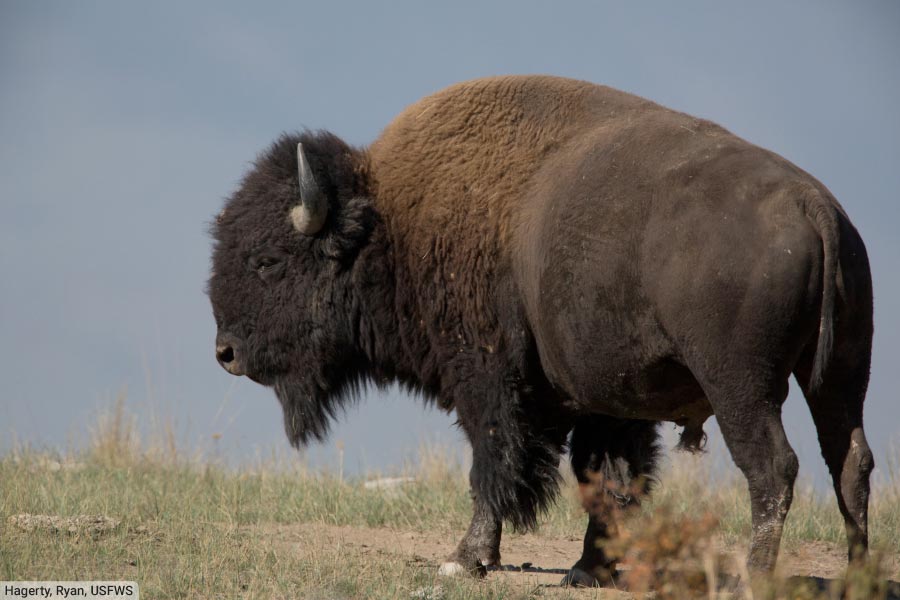
- Scientific identify: Bison bison
- Class: Mammalia
- Order: Artiodactyla
- Household: Bovidae
- Conservation Standing: Close to Threatened
The American bison, additionally known as buffalo, is the most important land mammal in North America, with males weighing as much as 2,000 kilos. It’s recognizable by its huge head, humped shoulders, and shaggy brown coat.
This iconic Yellowstone Park species is a grazing herbivore, feeding primarily on grasses. It performs a vital ecological function, shaping plant communities and offering habitat for different wildlife.
The American bison as soon as roamed the continent in huge herds, however because of overhunting, virtually turned extinct.
Yellowstone Nationwide Park hosts the oldest and largest public bison herd in america, with animals roaming freely since prehistoric occasions. This herd is genetically pure and managed as wildlife, not livestock.
It’s not unusual for site visitors to be dropped at a halt within the park as a herd of bison crosses the street!
Uncover Extra With Energetic Wild
American White Pelican
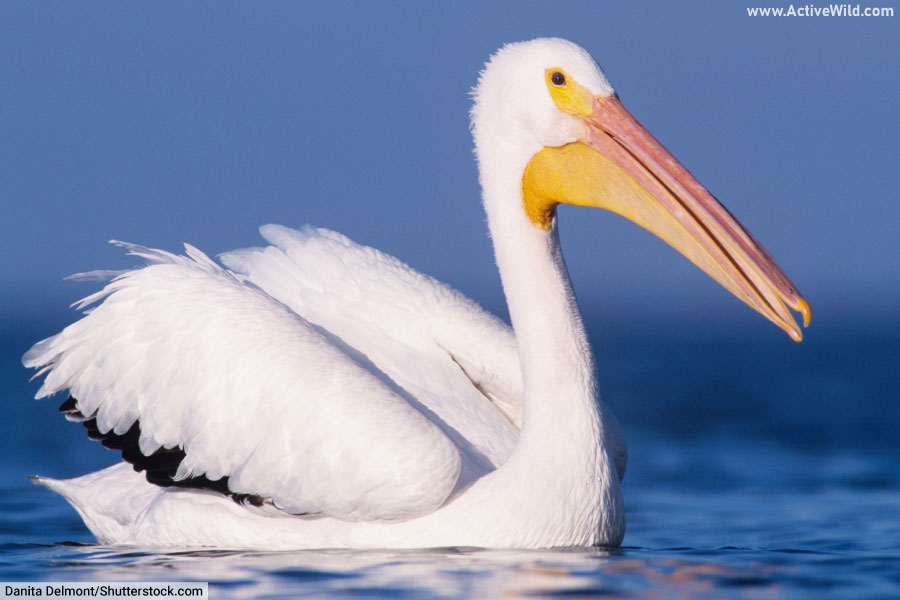

- Scientific identify: Pelecanus erythrorhynchos
- Class: Aves
- Order: Pelecaniformes
- Household: Pelecanidae
- Conservation Standing: Least Concern
The American white pelican is one in every of North America’s largest birds, with a wingspan reaching as much as 9 toes. (Just one different North American fowl—the California Condor—has a bigger wingspan.)
The pelican is well distinguished from different Yellowstone birds by its vivid white plumage, black wing suggestions, and lengthy orange invoice with a throat pouch for scooping fish.
The species feeds cooperatively, typically working in teams to herd fish into shallow water earlier than dipping its invoice to catch prey.
These giant birds breed in giant colonies on distant islands in inland lakes. In Yellowstone Nationwide Park, American white pelicans are generally seen at Yellowstone Lake, the place they feed on cutthroat trout and different fish. The park’s colony on the lake’s Molly Islands is among the few high-elevation nesting websites for this species in North America.
Uncover Extra With Energetic Wild
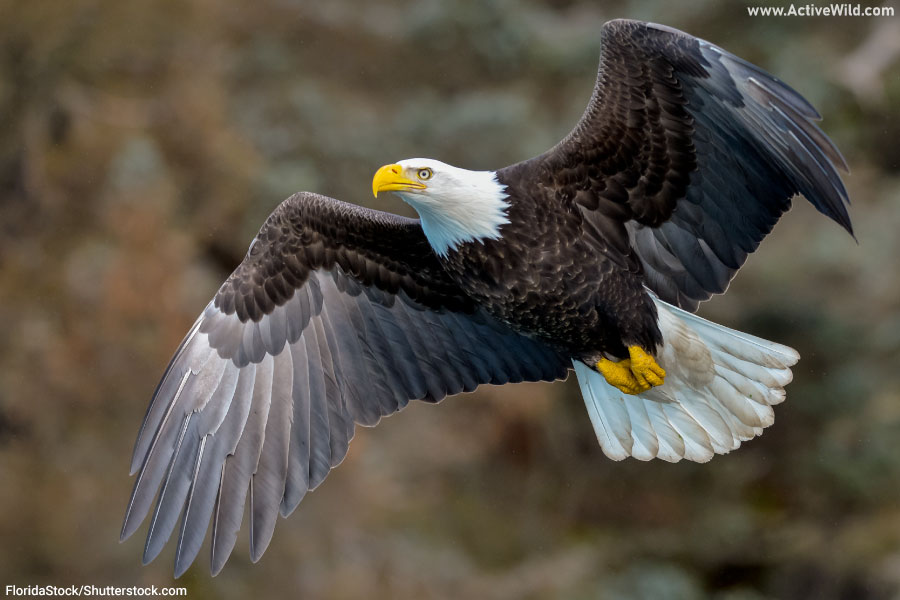

Bald Eagle
- Scientific identify: Haliaeetus leucocephalus
- Class: Aves
- Order: Accipitriformes
- Household: Accipitridae
- Conservation Standing: Least Concern
The bald eagle is a big fowl of prey native to North America, acknowledged by its white head and tail contrasting with a darkish brown physique and wings, plus a yellow beak and talons.
With a wingspan of as much as 7.5 toes, the eagle is a robust flier and expert hunter, feeding primarily on fish but in addition on waterfowl, small mammals, and carrion. They nest in tall bushes or snags, typically reusing the identical giant stick nest for a few years.
As soon as endangered on account of searching, habitat loss, and DDT pesticide use, it has rebounded by authorized safety and conservation efforts.
In Yellowstone Nationwide Park, bald eagles are discovered close to rivers and lakes, particularly the Yellowstone River and Yellowstone Lake, the place fish are ample.
Uncover Extra With Energetic Wild
Bighorn Sheep


- Scientific identify: Ovis canadensis
- Class: Mammalia
- Order: Artiodactyla
- Household: Bovidae
- Conservation Standing: Least Concern
The bighorn sheep is a sturdy wild sheep native to North America, named for the males’ huge, curled horns, which might weigh as much as 30 kilos. Ewes have shorter, extra slender horns.
Tailored to rugged mountain terrain, bighorn sheep are sure-footed climbers, utilizing steep cliffs for escape from predators. They graze primarily on grasses, shrubs, and herbs, with weight loss plan various by season.
Males interact in dramatic head-butting contests in the course of the fall rut, generally colliding at speeds over 20 mph.
In Yellowstone Nationwide Park, bighorn sheep are most frequently seen within the rocky cliffs close to the Gardiner River and Mount Everts.
Uncover Extra With Energetic Wild
American Black Bear
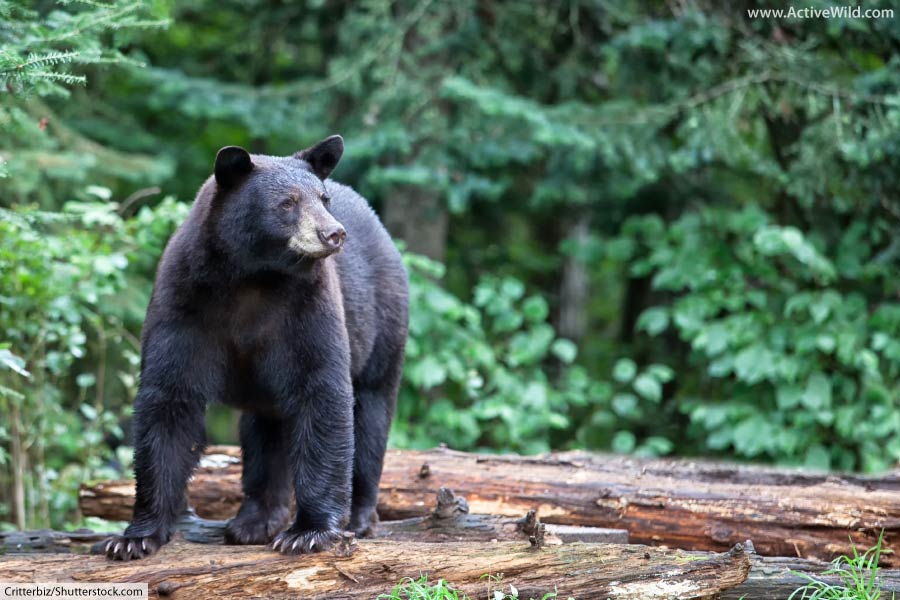

- Scientific identify: Ursus americanus
- Class: Mammalia
- Order: Carnivora
- Household: Ursidae
- Conservation Standing: Least Concern
The American black bear is probably the most widespread bear species in North America, the place it’s sometimes present in woodland or forest habitats. It’s one in every of two bear species present in Yellowstone Nationwide Park, the opposite being the grizzly bear (a subspecies of brown bear), listed additional down the web page.
Grownup American black bears sometimes weigh between 100 and 600 kilos, with males bigger than females. Omnivorous and opportunistic, black bears eat vegetation, berries, nuts, bugs, fish, and carrion. They’re wonderful climbers and might run as much as 30 mph.
In Yellowstone Nationwide Park, black bears are generally seen in forested areas and alongside roadsides in spring, feeding on rising vegetation. Black bears in Yellowstone normally hibernate in dens from late fall to early spring.
Uncover Extra With Energetic Wild
Barred (Western) Tiger Salamander


- Scientific identify: Ambystoma mavortium
- Class: Amphibia
- Order: Urodela (Caudata)
- Household: Ambystomatidae
- Conservation Standing: Least Concern
The barred tiger salamander, often known as the western tiger salamander, is among the largest terrestrial salamanders in North America, sometimes measuring 17–33 cm (6.7–13 in) in size and weighing 126–227 g (4.4–8 oz). It has a sturdy physique with darkish brown to black pores and skin marked by yellow or olive blotches or bars.
One among simply 5 amphibian species present in Yellowstone, this nocturnal animal spends most of its life underground in burrows, rising primarily on wet nights. It feeds on bugs, worms, small amphibians, and even younger mice.
Breeding happens in ponds and slow-moving waters, the place it lays gelatinous egg lots.
In Yellowstone Nationwide Park, western tiger salamanders inhabit wetlands, ponds, and lakes at decrease to mid-elevations, significantly within the northern vary and Hayden Valley. They play an vital ecological function by controlling insect populations and serving as prey for birds and mammals.
Uncover Extra With Energetic Wild
Boreal Refrain Frog


- Scientific identify: Pseudacris maculata
- Class: Amphibia
- Order: Anura
- Household: Hylidae
- Conservation Standing: Least Concern
The boreal refrain frog is one in every of solely 5 amphibian species present in Yellowstone Nationwide Park. It’s a small amphibian, sometimes measuring 2–4 cm (0.75–1.5 in) in size. Its clean pores and skin can vary in shade from inexperienced to brown or grey, typically marked with three darkish stripes down its again. Recognized for its loud, rising “cree-ee-ee-eeek” name, it is among the earliest frogs to breed in spring, generally calling when ice nonetheless covers elements of ponds.
Boreal refrain frogs reside in wetlands, marshes, and moist meadows, feeding on small bugs and different invertebrates. In Yellowstone Nationwide Park, they inhabit low- to mid-elevation wetland areas. Their early breeding habits and adaptableness permit them to thrive in Yellowstone’s brief, cool summers, making them an vital a part of the park’s amphibian group.
Uncover Extra With Energetic Wild
Coyote
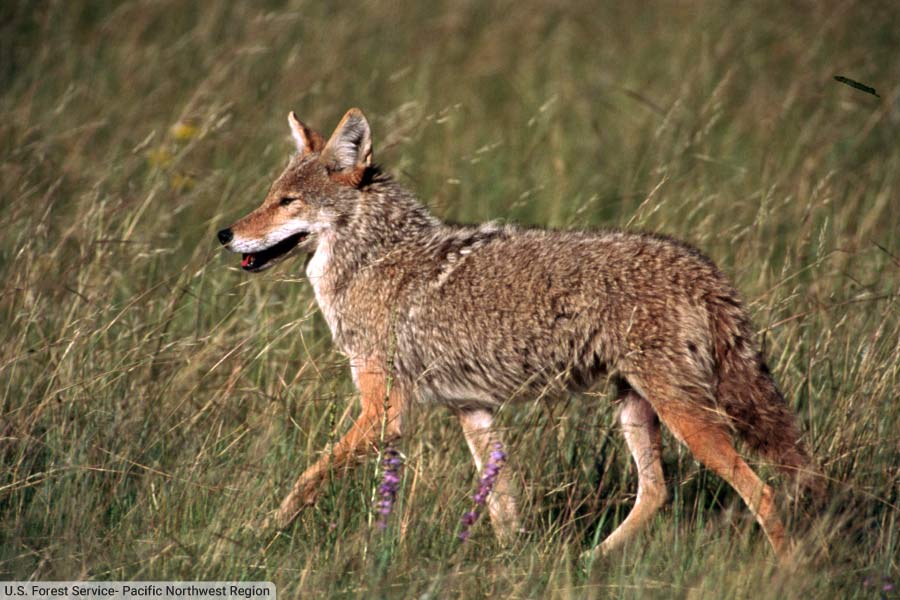

- Scientific identify: Canis latrans
- Class: Mammalia
- Order: Carnivora
- Household: Canidae
- Conservation Standing: Least Concern
The coyote is a extremely adaptable member of the canine household discovered throughout North America, from deserts to forests and even city areas. Adults sometimes weigh 9–23 kg (20–50 lb) and measure 1–1.3 m (3.3–4.3 ft) from nostril to tail.
Coyotes have a slender construct, pointed ears, and a bushy tail, with fur that ranges from grayish-brown to reddish-tan. Omnivorous and opportunistic, they eat small mammals, birds, carrion, fruit, and bugs.
Recognized for his or her intelligence and sophisticated vocalizations, coyotes typically hunt alone or in pairs however might kind small packs.
In Yellowstone Nationwide Park, they’re ceaselessly seen in open valleys like Lamar and Hayden, the place they prey on rodents and scavenge from wolf kills, enjoying an vital function within the park’s predator-prey dynamics.
Sadly, these clever animals can lose their wariness round people within the park, resulting in begging conduct aggression.
Uncover Extra With Energetic Wild
Elk
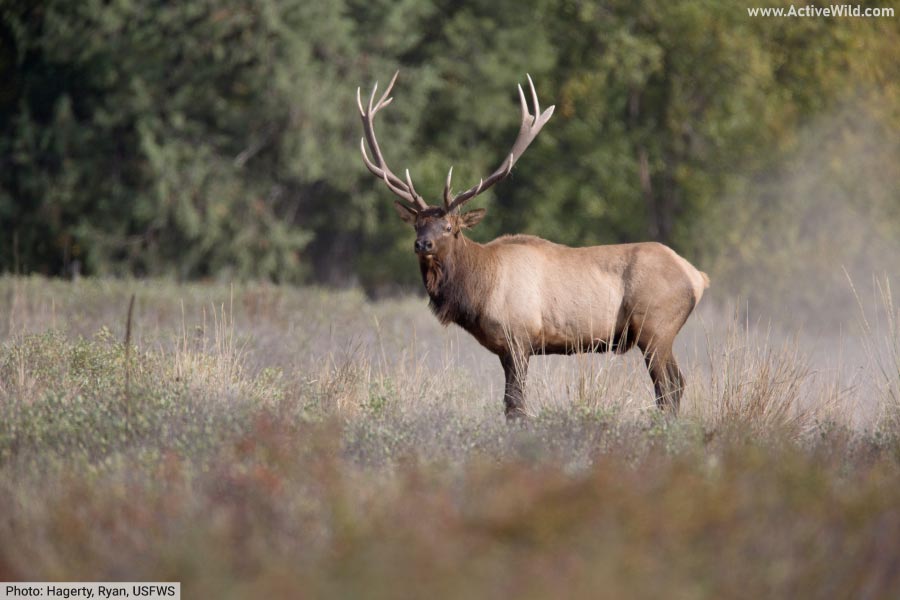

- Scientific identify: Cervus canadensis / Cervus elaphus
- Class: Mammalia
- Order: Artiodactyla
- Household: Cervidae
- Conservation Standing: Least Concern
The elk is among the largest members of the deer household, with males (bulls) weighing 320–500 kg (700–1,100 lb) and standing about 1.5 m (5 ft) tall on the shoulder. Females (cows) are smaller, weighing 225–320 kg (500–700 lb).
Elk have a reddish-brown coat in summer season that turns grayish-brown in winter, with a particular pale rump. Bulls develop giant, branching antlers that may span over 1.2 m (4 ft) and are shed every winter. They’re herbivores, grazing on grasses, shrubs, and tree bark.
In Yellowstone Nationwide Park, elk are one of the crucial ample giant mammals and a key meals supply for predators like wolves and bears. They’re typically seen in valleys, meadows, and alongside river corridors year-round.
Uncover Extra With Energetic Wild
Grey Wolf
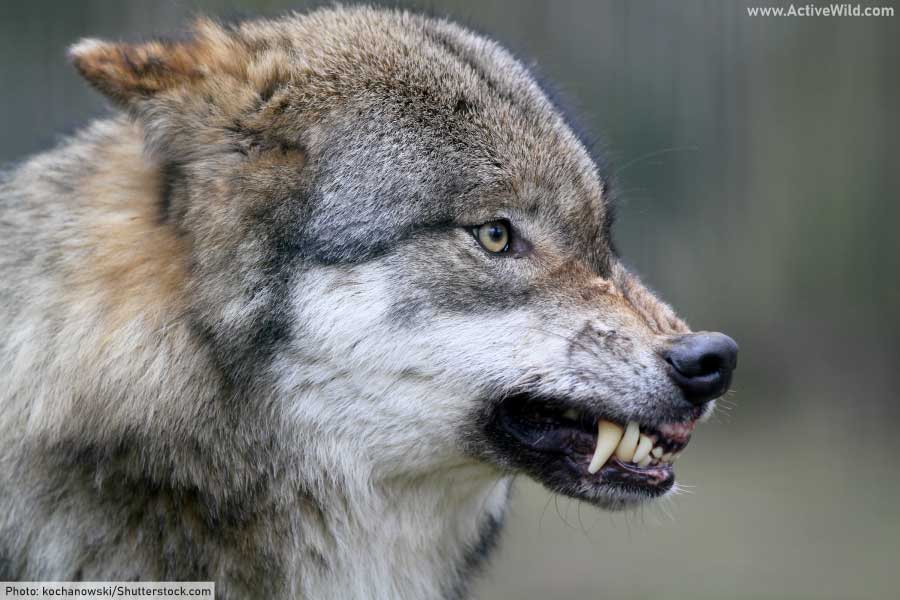

- Scientific identify: Canis lupus
- Class: Mammalia
- Order: Carnivora
- Household: Canidae
- Conservation Standing: Least Concern
The grey wolf is a big canid (member of the canine household) that sometimes weighs 30–50 kg (66–110 lb) and measures 1.3–1.6 m (4.3–5.2 ft) from nostril to tail, with a shoulder top of 60–90 cm (24–35 in). It has a thick, insulating coat that varies in shade from grey to black or white.
Wolves reside and hunt in family-based packs, utilizing teamwork to pursue prey resembling elk, deer, and bison. They convey by vocalizations (together with their well-known howl), scent marking, and physique language.
In Yellowstone Nationwide Park, grey wolves had been reintroduced in 1995 after a decades-long absence, restoring a vital predator to the ecosystem. As a keystone species, their presence has had wide-reaching ecological results, influencing prey populations and even vegetation patterns through a course of often known as a trophic cascade.
Uncover Extra With Energetic Wild
Grizzly Bear
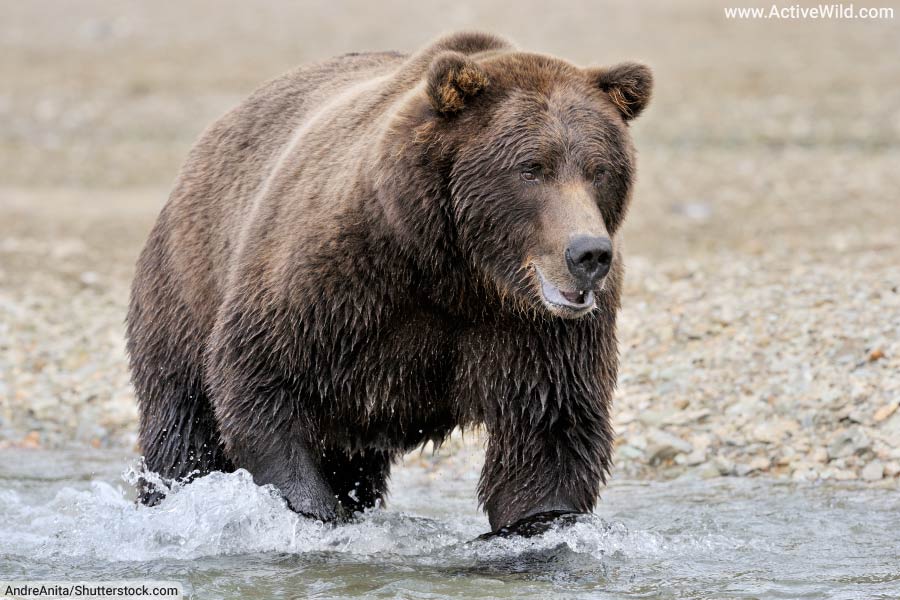

- Scientific identify: Ursus arctos horribilis
- Class: Mammalia
- Order: Carnivora
- Household: Ursidae
- Conservation standing: Least Concern
The grizzly bear is a robust subspecies of the brown bear, sometimes weighing 180–360 kg (400–800 lb) for males and 130–200 kg (290–440 lb) for females, with a size of two–2.5 m (6.5–8 ft) and a shoulder top of about 1 m (3.3 ft). It’s recognizable by its muscular shoulder hump, concave facial profile, and lengthy claws fitted to digging. Fur shade ranges from mild brown to almost black, typically with grizzled suggestions.
Omnivorous, grizzlies eat vegetation, berries, roots, bugs, fish, and enormous mammals. In Yellowstone Nationwide Park, they roam forests, meadows, and river valleys, particularly in spring when feeding on winter-killed animals. Grizzlies are a key apex predator within the park, influencing prey populations and serving to keep ecological steadiness.
Uncover Extra With Energetic Wild
Moose
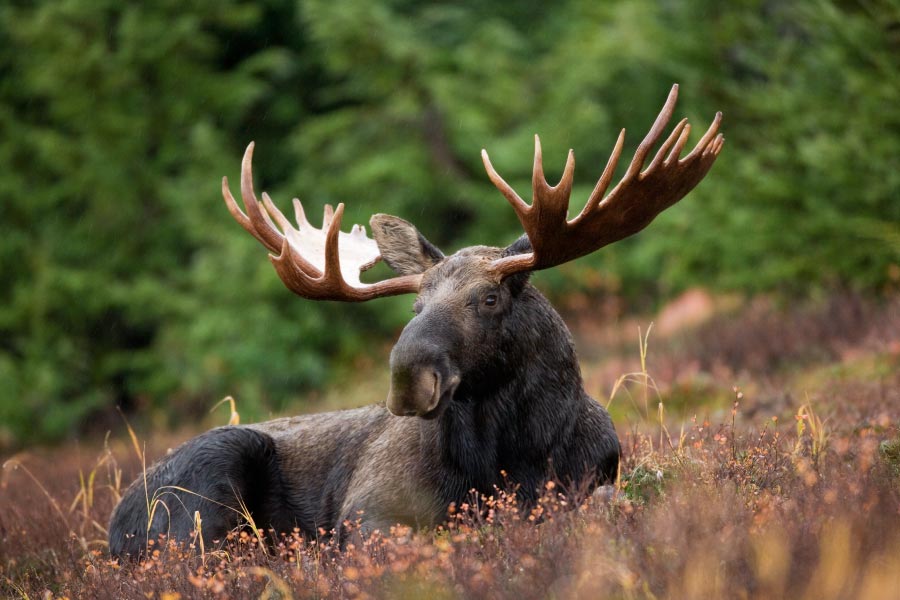

- Scientific identify: Alces alces
- Class: Mammalia
- Order: Artiodactyla
- Household: Cervidae
- Conservation Standing: Least Concern
The moose is the most important member of the deer household, with males (bulls) weighing 380–700 kg (840–1,540 lb) and standing 1.5–2.1 m (5–7 ft) tall on the shoulder. Females (cows) are smaller, at 270–360 kg (600–800 lb).
These unmistakeable giant mammals have lengthy legs, a humped shoulder, a big, overhanging nostril, and in males, broad, palmate antlers that may span as much as 1.8 m (6 ft). Their darkish brown coat supplies insulation in chilly climates. Moose are browsers, feeding on willows, aspens, aquatic vegetation, and shrubs.
In Yellowstone Nationwide Park, moose are most frequently present in marshy areas, willow flats, and alongside rivers, significantly within the park’s southern reaches. Their presence is intently tied to wetland habitats, which give each meals and canopy.
Uncover Extra With Energetic Wild
Mountain Lion (often known as Cougar or Puma)
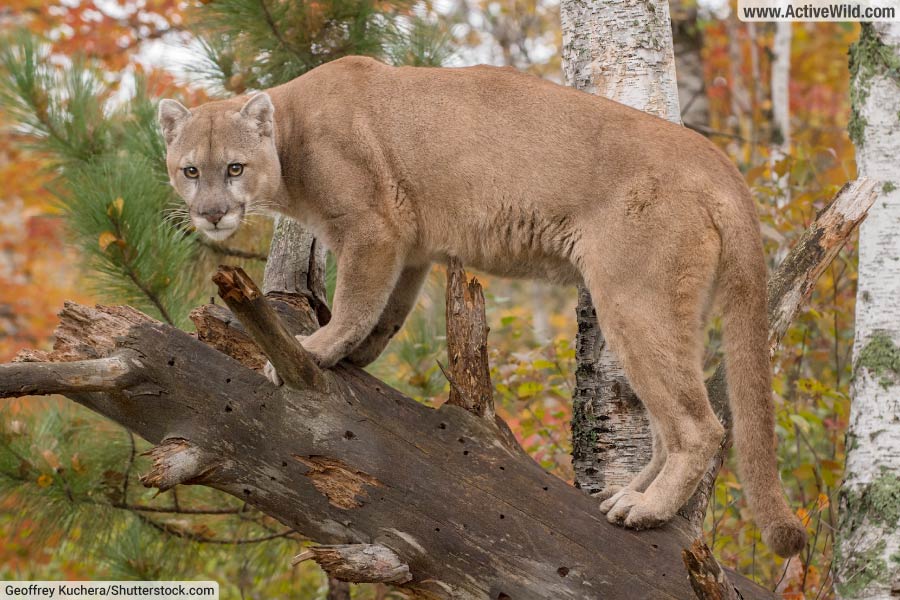

- Scientific identify: Puma concolor
- Class: Mammalia
- Order: Carnivora
- Household: Felidae
- Conservation Standing: Least Concern
The mountain lion, often known as cougar or puma, is a big, solitary cat weighing 29–90 kg (64–198 lb) and measuring 2–2.7 m (6.6–8.9 ft) from nostril to tail, with a shoulder top of 60–90 cm (24–35 in). It has a modern, tawny coat, a protracted tail tipped with black, and highly effective limbs for sprinting and leaping.
Mountain lions are carnivores, primarily searching deer but in addition preying on elk, bighorn sheep, and smaller animals. They’re elusive and principally energetic at daybreak, nightfall, or evening.
In Yellowstone Nationwide Park, mountain lions inhabit forested and rocky terrain, utilizing stealth to ambush prey. Though not often seen by guests, they play a significant function as apex predators, serving to regulate ungulate populations and keep ecosystem steadiness.
Different cat species present in Yellowstone park embrace the bobcat and the Canada lynx.
Uncover Extra With Energetic Wild
Mule Deer
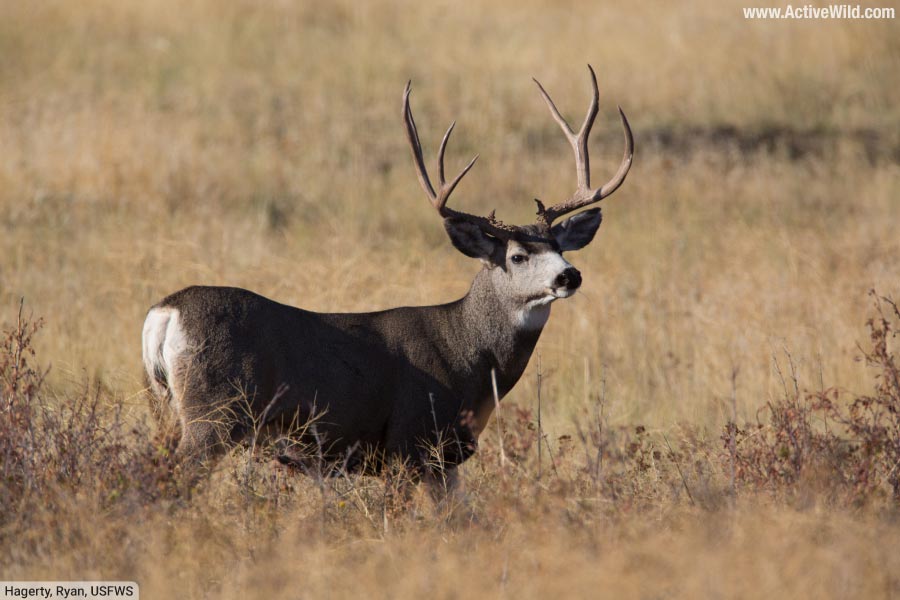

- Scientific identify: Odocoileus hemionus
- Class: Mammalia
- Order: Artiodactyla
- Household: Cervidae
- Conservation Standing: Least Concern
The mule deer is a medium-to-large deer species, with males (bucks) weighing 55–150 kg (120–330 lb) and females (does) 43–80 kg (95–180 lb). They stand about 1–1.1 m (3.3–3.6 ft) tall on the shoulder and measure 1.2–2.1 m (4–7 ft) in size.
Mule deer are named for his or her giant, mule-like ears and have a stocky construct, a black-tipped tail, and a reddish-brown summer season coat that turns grayish-brown in winter. Males develop forked antlers that department into two primary tines. They feed on shrubs, leaves, and grasses.
In Yellowstone, mule deer are present in open forests, grasslands, and river valleys, typically migrating between larger summer season ranges and decrease wintering grounds. They’re prey for wolves, mountain lions, and coyotes.
Uncover Extra With Energetic Wild
Prairie Rattlesnake


- Scientific identify: Crotalus viridis
- Class: Reptilia
- Order: Squamata
- Household: Viperidae
- Conservation Standing: Least Concern
Solely six species of reptile are present in Yellowstone, of which the most important is the prairie rattlesnake.
This venomous pit viper sometimes measures 90–120 cm (3–4 ft) in size, although some can develop as much as 150 cm (5 ft). It has a thick, tan to greenish-brown physique with darkish blotches alongside its again and a particular rattle on the finish of its tail, used as a warning sign.
Warmth-sensing pits between the eyes and nostrils assist it detect warm-blooded prey resembling rodents, birds, and small mammals. The prairie rattlesnake makes use of potent venom to immobilize prey and for self-defense.
In Yellowstone Nationwide Park, the snake is primarily discovered within the park’s decrease, drier northern areas, particularly close to rocky outcrops and grasslands. It’s the solely venomous snake species within the park and performs an vital function in controlling rodent populations.
Uncover Extra With Energetic Wild
Pronghorn
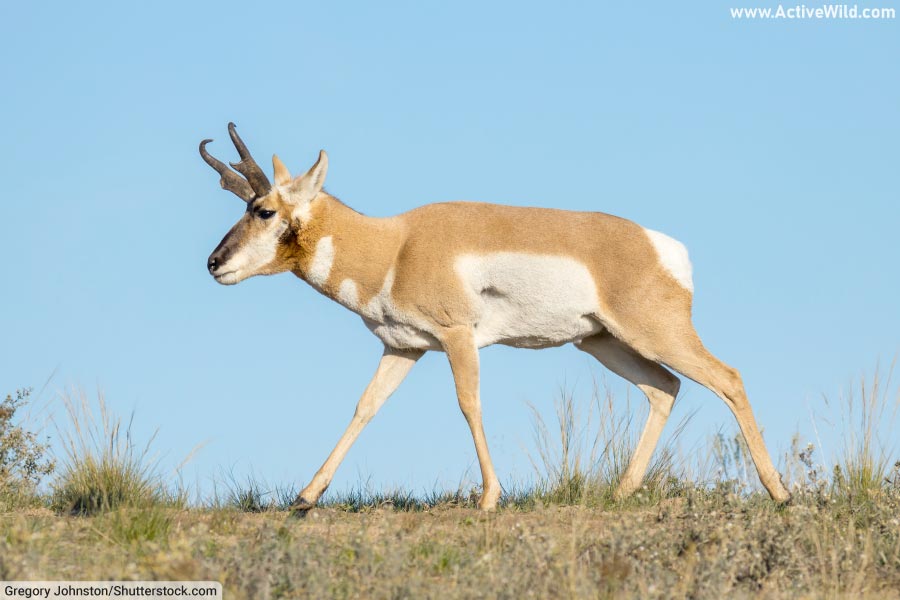

- Scientific identify: Antilocapra americana
- Class: Mammalia
- Order: Artiodactyla
- Household: Antilocapridae
- Conservation Standing: Least Concern
The pronghorn, typically known as pronghorn antelope although it’s not a real antelope, is a swift, hoofed mammal weighing 40–65 kg (88–143 lb) and standing 90 cm (3 ft) tall on the shoulder. It measures 1.3–1.5 m (4.3–5 ft) in size.
Pronghorns have a tan physique with white underparts, a white rump patch, and distinct black markings on the face. Each women and men develop keratin-sheathed horns, with males’ reaching 25–43 cm (10–17 in) and shedding yearly.
Famend for his or her velocity, pronghorns can run as much as 88 km/h (55 mph), making them the quickest land mammals in North America.
In Yellowstone Nationwide Park, pronghorns inhabit open grasslands and sagebrush flats, significantly within the northern vary, the place they graze on forbs, shrubs, and grasses.
Uncover Extra With Energetic Wild
Sandhill Crane


- Scientific identify: Antigone canadensis
- Class: Aves
- Order: Gruiformes
- Household: Gruidae
- Conservation Standing: Least Concern
Each of North America’s crane species—the sandhill crane and whooping crane—are present in Yellowstone.
The sandhill crane is a tall, long-legged fowl standing 90–120 cm (3–4 ft) excessive, with a wingspan of 1.6–2.3 m (5.2–7.5 ft) and weighing 3–6.3 kg (6.6–14 lb). It has grey plumage that will seem reddish-brown from preening with iron-rich mud, a protracted neck, and a particular crimson crown.
Recognized for his or her loud, trumpeting calls and elaborate courtship dances, sandhill cranes are omnivores, feeding on seeds, grains, bugs, small vertebrates, and aquatic vegetation. They nest in open wetlands, constructing mounded platforms from vegetation.
In Yellowstone Nationwide Park, sandhill cranes return every spring to breed in marshes and moist meadows, particularly within the park’s northern vary. Their resonant calls could be heard over nice distances, marking one in every of Yellowstone’s most iconic fowl sounds.
Uncover Extra With Energetic Wild
Trumpeter Swan
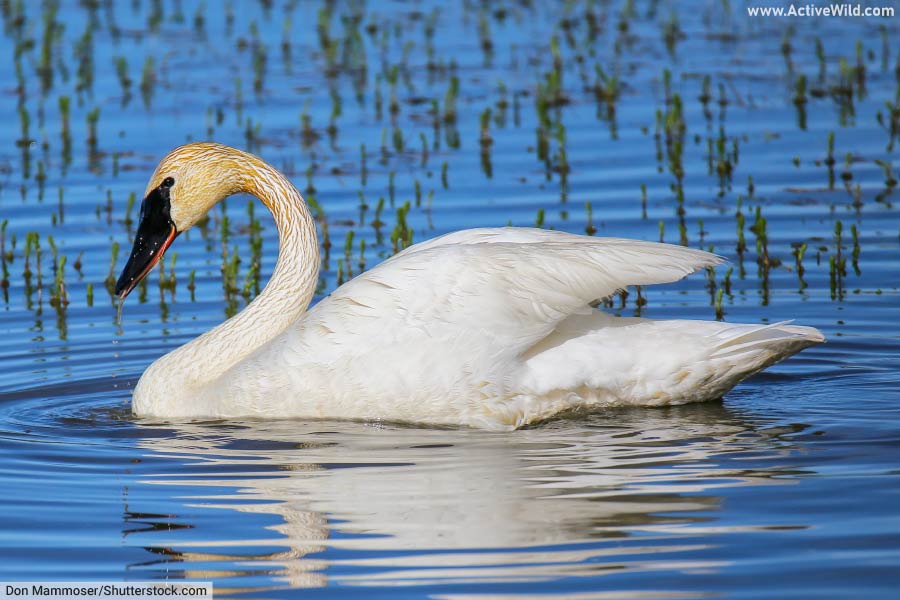

- Scientific identify: Cygnus buccinator
- Class: Aves
- Order: Anseriformes
- Household: Anatidae
- Conservation Standing: Least Concern
The trumpeter swan is the most important native waterfowl in North America, standing about 1.2–1.5 m (4–5 ft) tall, with a wingspan of two–3 m (6.5–10 ft) and weighing 7–13.6 kg (15–30 lb). It has pure white plumage, a protracted neck, and a black invoice that usually reveals a salmon-colored stripe alongside the mouthline.
Recognized for its deep, trumpet-like name, the species was as soon as close to extinction on account of overhunting and habitat loss however has rebounded by conservation efforts.
Trumpeter swans feed primarily on aquatic vegetation, utilizing their lengthy necks to achieve vegetation beneath the water’s floor.
In Yellowstone Nationwide Park, these swans are discovered on lakes, ponds, and slow-moving rivers, with a notable presence on Yellowstone Lake, the place some pairs stay year-round regardless of harsh winter circumstances.
Uncover Extra With Energetic Wild
White‑Tailed Deer


- Scientific identify: Odocoileus virginianus
- Class: Mammalia
- Order: Artiodactyla
- Household: Cervidae
- Conservation Standing: Least Concern
The white-tailed deer is a medium-sized deer species, with males (bucks) weighing 57–136 kg (125–300 lb) and females (does) 41–94 kg (90–210 lb). They stand about 90–100 cm (3–3.3 ft) tall on the shoulder and measure 1.6–2 m (5.2–6.6 ft) in size.
Their reddish-brown summer season coat turns grayish-brown in winter, and they’re simply acknowledged by the white underside of their tail, which they elevate as a warning sign when alarmed. Males develop antlers which can be shed and regrown annually.
White-tailed deer are herbivores, feeding on leaves, twigs, fruits, and grasses.
Regardless of being North America’s most typical deer species, white-tailed deer are much less frequent than mule deer in Yellowstone Nationwide Park. They primarily inhabit river bottoms and lower-elevation areas within the park’s northern vary.
Uncover Extra With Energetic Wild
Yellowstone Cutthroat Trout


- Scientific identify: Oncorhynchus clarkii bouvieri
- Class: Actinopterygii
- Order: Salmoniformes
- Household: Salmonidae
- Conservation Standing: Least Concern
The Yellowstone cutthroat trout is a subspecies of Rocky Mountain cutthroat trout. It’s a freshwater fish sometimes measuring 30–60 cm (12–24 in) in size and weighing 0.5–2.3 kg (1–5 lb), although bigger people can happen. It has a golden-brown physique with black spots concentrated towards the tail and distinctive red-orange slashes beneath the jaw.
The trout is native to the Yellowstone River drainage and performs a key function within the park’s aquatic and terrestrial ecosystems, offering meals for bears, otters, ospreys, and different wildlife. Spawning happens in shallow, gravel-bottomed streams in spring and early summer season.
Yellowstone Lake helps one of many largest inland cutthroat trout populations.

